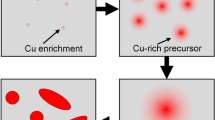Abstract
Nucleation of new phases originated by mechanochemical activation of the reactants is considered. The decrease in nucleation energy of high-melting powders modified with silicon alkoxide is achieved via formation of carbon clathrates in SiO2 and self-organized high-activity ensemble with a specified proportion of cybotactic groups. The stability of newly-formed β-SiC and mullite synthesized by a mechanochemical method is discussed.
Similar content being viewed by others
REFERENCES
A.West, Solid State Chemistry and Its Applications, JohnWiley & Sons, Chichester (U.K.) (1984).
R. S. Saifullin, Physical Chemistry of Inorganic Polymer and Composite Materials [in Russian], Khimia, Moscow (1990).
2. G. Heinicke, Tribochemistry, Akademie-Verlag, Berlin (1984).
G. D. Semchenko, “Mechanochemical reactions of electrofused corundum and silicon alkoxide,” in: Research Conference “Mechanochemistry and Mechanical Activation. Technological Aspects,” Abstracts [in Russian], MKhA RAN, St. Petersburg (1995), pp. 124–128.
G. D. Semchenko, “Low-temperature synthesis of SiC by thermal treatment of hydrolyzed ethyl silicate gels,” Ogneup. Tekh. Keram., No. 9}, 14–19 (1996
N. K. Baramboi, Mechanochemistry of High-Molecular Compounds [in Russian], Khimiya, Moscow (1978).
N. N. Pavlov, Theoretical Foundations of General Chemistry [in Russian], Vysshaya Shkola, Moscow (1978).
E. G. Avvakumov, Mechanical Methods of Activation of Chemical Processes [in Russian], Nauka, Novosibirsk (1979).
A. V. Galakhov, “Sintering of aerosol powders,” Ogneup. Tekh. Keram., No. 1-2, 29–33 (1999).
N. L. Glinka, General Chemistry [in Russian], Khimiya, Leningrad (1976).
V. F. Dorfman, Synthesis of Solid-State Structures [in Russian], Moscow, Metallurgiya (1986).
Yu. M. Putilin, Yu. A. Belyakova, V. P. Golovko, et al., Synthesis of Minerals, Vol. 2 [in Russian], Nedra, Moscow (1987).
G. D. Semchenko, “—Premena ethylsilikatovych vazeb a chemismus jejich reakce s korundovym plnivem pri zahprivani,” Stavivo, No. 4, 130–131 (1984).
G. D. Semchenko, O. B. Skorodumova, and G. A. Gogotzi, “Elaboration of ultrafine mullite powder and strong advanced ceramics from sol-gel method,” in: 4th European Ceramic Society Conference, Riccione (Italy), Vol. 1 (1995), pp. 97–104.
I. S. Kainarskii and É. V. Degtyareva, “Routes toward reducing the oxidability of carborundum refractories,” Ogneupory, No. 2, 77–85 (1960).
Author information
Authors and Affiliations
Rights and permissions
About this article
Cite this article
Semchenko, G.D., Opryshko, I.N., Angolenko, L.A. et al. Mechanochemical Nucleation and Stability of Newly-Formed Phases. Refractories and Industrial Ceramics 45, 181–184 (2004). https://doi.org/10.1023/B:REFR.0000036726.93461.af
Issue Date:
DOI: https://doi.org/10.1023/B:REFR.0000036726.93461.af




